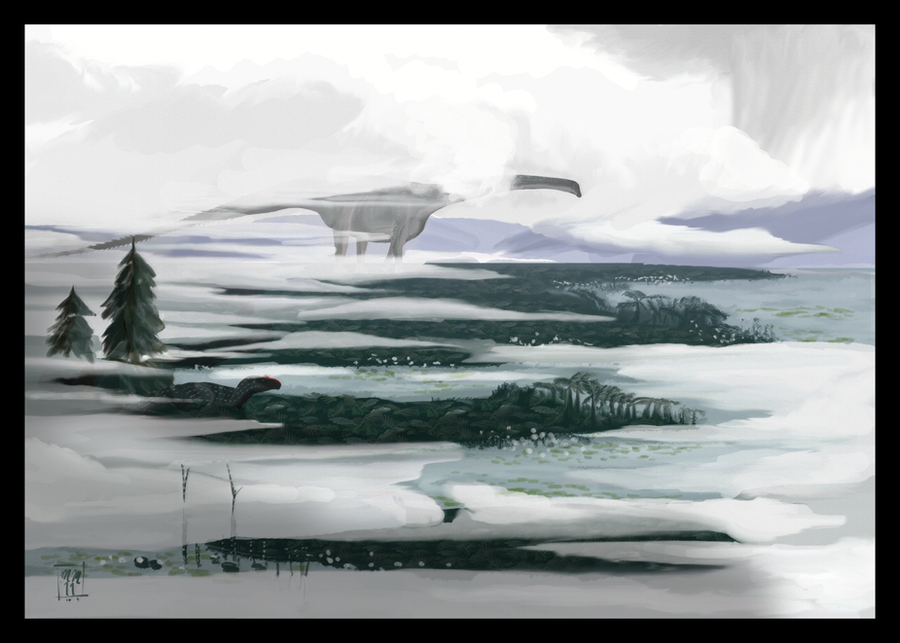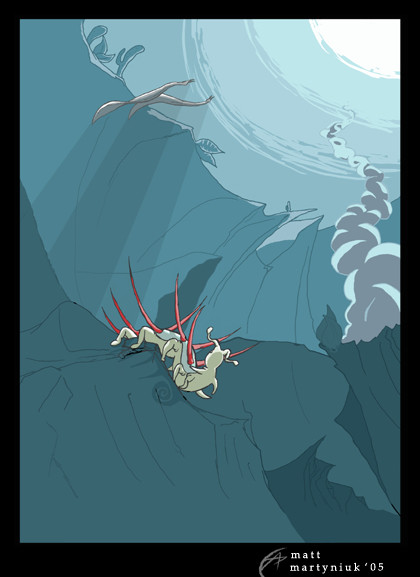HOME | DD
 MattMart — A Titan Emerges from the Fog
MattMart — A Titan Emerges from the Fog

Published: 2011-10-09 15:53:56 +0000 UTC; Views: 4520; Favourites: 141; Downloads: 0
Redirect to original
Description
Updated illustration of Amphicoelias fragillimus, depicted approaching a Morrison Formation waterway through the early morning fog while an Allosaurus fragilis wakes up nearby.I used a color palette inspired by classic Charles Knight paintings, as well as by this one [link] by John Conway.
Related content
Comments: 26

Wonderful! I love, how you made it look so mysterious with all the fog!
And also, that you only put the spines onto the sauropod's tail.
👍: 0 ⏩: 0

Is the Allosaurus fragilis in your pic supposed to be the average 28-30 foot long or a 39-40 foot long animal?
👍: 0 ⏩: 1

I believe I based it on the AMNH mounted specimen which is around 30ft, but with nothing else is the foreground to really compare it to other than some tree ferns the scale wasn't as important in this one.
👍: 0 ⏩: 1

My problem with his numbers is that Carpenter says Amphicoelias has a 2.7 meter tall D9, the corresponding vert in diplodocus is about .95 meters tall. In the paper he basically says he just scaled up diplodocus to Amp's vert. dimensions. This means Amp is 2.85 times as long as Diplodocus, or 27x2.85=77meters. This increase would drastically effect weight estimates as well.
👍: 0 ⏩: 0

What is you opinion on the max size of Amphicoelias?
👍: 0 ⏩: 1

I can't think of any reason to disagree with Ken Carpenter's calculations published in 2006, at least as far as length goes. Basing it on a simply scaled-up Diplodocus is the best we can do with the available evidence. That is, it was most likely about 58m long. As for weight... who knows. Every other study seems to get different values for dinosaur weight, let alone a dinosaur based on a single bone
👍: 0 ⏩: 0

Wow, this is epic, breathtaking and beautiful. This score [link] came to mind as I looked at your new artwork. I fell you should add it (or something similar) as a link to add atmosphere to the piece 
👍: 0 ⏩: 0

Looks realy epic. So about how high would have Amphicoelias been in normal posture ?? About 20 m ?
👍: 0 ⏩: 1

Probably more like 15-17m, I doubt the neck would have been able to go completely vertical as shown in old movies. Diplodocid necks could raise up, but at more of a 45 degree angle from the shoulder.
👍: 0 ⏩: 0

This is epic, really makes out for the majesty and awesomeness of the beast
But is it really that huge compared to the forest trees? Or had my sleepy eyes confused me?
👍: 0 ⏩: 1

Well, I deliberately set this on a flat plain dominated by ferns and cycads to accentuate its size. You can see by the presence of the allosaur that even the conifers aren't particularly tall.
If A. fragillimus had the same proportions of a scaled-up diplodoc, it would have been around 9-10m (about 30ft) tall at the hip. That's pretty big but there could have been redwoods over 30m (100ft) tall in some parts of its environment. Studies show that the Morrison ecosystem was mostly plains dominated by ferns, but that there were also rarer gallery forests of redwoods etc. which grew near the banks of rivers.
👍: 0 ⏩: 1

Oh so it's a fern plain
And I had just realised that there was an Allosaurus resting there, naturally camouflaged, Neato! XD
👍: 0 ⏩: 0

Wow, I honestly find it too hard to believe such a beast existed. 45-60m long is massive!
Also, what's with the spiky tail?
👍: 0 ⏩: 1

Well, evidence from other sauropods shows the back was at least partially covered in small dermal spines (early reconstructions got this wrong by showing only a single row of spines down the back like an iguana). I made them longer on the tail as sort of a speculative display or defensive feature.
👍: 0 ⏩: 1

Wait a sec, there are more than one rows of spines on sauropods? Any links for this evidence?
👍: 0 ⏩: 1

No published sources yet, but see Scott Hartman's comments here: [link]
👍: 0 ⏩: 1

hmm very interesting, thanks!
👍: 0 ⏩: 0

Wow, what an interesting and original concept! I think the palette works really well.
👍: 0 ⏩: 0



































